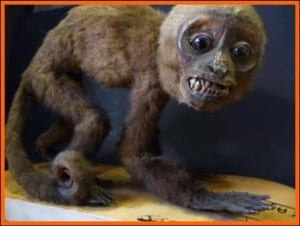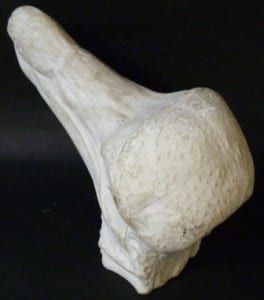Specimen of the Week: Week Forty-Seven
By Emma-Louise Nicholls, on 3 September 2012
 A while back I went to a pub quiz with my parents. I think that they, and their fellow team members, were under the impression that I and my four degrees would bring a dose of omniscience to the table. Four degrees I do have, but they are not four degrees in general knowledge. Sadly, for my team. Rather, they are in a niche area getting more and more specialised as you travel up the qualification scale. If you want to know the average length of a sand tiger shark’s right clasper, give me a shout and a gold medal. But otherwise I’m sadly lacking in value when it comes to providing an answer. You can imagine my delight therefore, when my moment came to shine and prove my worth, as the compere asked a question on zoology. So elated was I that in a fit of new found confidence I shouted ‘Can we have a bonus point if we know the scientific name?’ to which the lady surprisingly and inconveniently agreed. I say inconveniently because I knew that I knew but in that moment, under the self-imposed pressure of the situation, could I remember that flinging flanging scientific name? You bet your snub-nosed monkey I couldn’t. Curses. So in an effort to prevent you my dear reader from ever suffering the same humiliation, I am now going to use it several times in this blog so that it becomes firmly implanted in all our memories. This week’s Specimen of the Week is…
A while back I went to a pub quiz with my parents. I think that they, and their fellow team members, were under the impression that I and my four degrees would bring a dose of omniscience to the table. Four degrees I do have, but they are not four degrees in general knowledge. Sadly, for my team. Rather, they are in a niche area getting more and more specialised as you travel up the qualification scale. If you want to know the average length of a sand tiger shark’s right clasper, give me a shout and a gold medal. But otherwise I’m sadly lacking in value when it comes to providing an answer. You can imagine my delight therefore, when my moment came to shine and prove my worth, as the compere asked a question on zoology. So elated was I that in a fit of new found confidence I shouted ‘Can we have a bonus point if we know the scientific name?’ to which the lady surprisingly and inconveniently agreed. I say inconveniently because I knew that I knew but in that moment, under the self-imposed pressure of the situation, could I remember that flinging flanging scientific name? You bet your snub-nosed monkey I couldn’t. Curses. So in an effort to prevent you my dear reader from ever suffering the same humiliation, I am now going to use it several times in this blog so that it becomes firmly implanted in all our memories. This week’s Specimen of the Week is…
***The Dodo Head Cast***
1) The dodo, scientific name Raphus cucullatus, used to live on Mauritius, a small island in the Indian Ocean. Although the ancestors of Raphus cucullatus probably arrived by air, Raphus cucullatus evolved to be flightless.
2) Recent research has found that the Raphus cucullatus (got it? Ok) is most closely related to pigeons, meaning that the dodo was the largest species of pigeon to have lived. We have several specimens at the Grant Museum, including many real bones, but the Specimen of the Week is a cast of an actual dodo head.
3) In a world where ‘everyone dreams of flying’, why would you clip your already aerobatically proficient primaries and start loping about on the ground all day every day. Well, because they could afford to. The Mauritius of the day, had no predators to speak of. So dodos didn’t *need* to fly. They gave up on flapping about in trees, building carefully balanced nests out of twigs and instead, their wings grew smaller, their bodies grew bigger, and they started nesting on the ground.
4) So all is going well for the dodo, living out its days on a remote desert island in the sun. But then, around the year 1600, life took a turn of the worse. The Europeans were busy traveling the world ‘claiming’ things, such as seas, land, other people… and then they found Mauritius. It was the Dutch in this particular story, that founded a colony on the island. Having spent so long at sea, the men were starved for fresh food and, although the dodo is recorded as not tasting very pleasant, the shoddy diet of the sailors up until this point meant that nevertheless, little cartoon roast chickens would pop up in front of their eyes when they looked at the dodos. What really did the dodo in however, was the other, four legged and furry, types of sailor that were also starved of fresh meat. Dogs and cats hunted the dodo, whilst habitat was cleared for farming and rearing pigs and goats. Egg eating rats inevitably poured out of the ships. The lack of previous natural predators that resulted in the loss of flight for the dodo also meant that the dodo did not evolve any particularly beneficial methods of defense. Sailors and furry predators alike therefore found they had easy access to the dodo’s nests and eggs.
5) There are no stuffed dodos anywhere today, if you’ve been told you’ve seen one it’s actually a composite model comprising elements of chicken, pigeon and/or turkey feathers. The Ashmolean Museum at Oxford did have a genuine taxidermy dodo for about a century, but in 1755 it was decided that it was in a very bad way and rather than carry out remedial conservation they decided it would be much a wiser decision to destroy the invaluable specimen. Wipe away that tear my friend, all was not lost. The head and a foot were saved from the fire which destroyed the rest, and casts were taken to increase longevity. It is one of these head casts that is honoured in this week’s Specimen of the Week. Please bow in reverence as you pass it in the Museum.
Emma-Louise Nicholls is the Museum Assistant at the Grant Museum of Zoology
4 Responses to “Specimen of the Week: Week Forty-Seven”
- 1
-
2
Angelina wrote on 6 January 2013:
Awesome article!! Btw,Whats the name of that scary monkey looking thing?
-
4
Specimen of the Week 200: The dodo | UCL Museums & Collections Blog wrote on 10 August 2015:

[…] visitors are so keen to see it. We have written about the dodo’s natural history and demise on this blog before, so I won’t repeat it again, but rather tell the tale of this collection of 35 […]
 Close
Close





It’s strange that the Dodo has become such a celebrity, and a poster bird for rapid human-caused extinction, when there were many other casualties contemporary to it. People unaccountably fail to get excited about the Broad Billed Parrot (also endemic to Mauritius), the Mauritian Duck or the Mascarene Coot (Mauritius and Reunion). They were all wiped out at roughly the same period (post 1600) by direct hunting, loss of habitat, competition with introduced species and predation by other introduced species such as rats, cats and dogs. Mention the sad extinction of the Bourbon Crested Starling (Reunion and a small population later accidentally introduced to Mauritius) merely merits you a broadside of blank stares. (Yet by all accounts it was much tastier than the Dodo.) Why should this be? There is one thing about the Dodo which has ensured its enduring popularity – its name. It was quirky sounding enough to warrant inclusion in books such as Lewis Carroll’s “Alice’s Adventures in Wonderland” (and, if you believe it, fitted in with Dodgson’s habitual stammer) and from then on its fame was assured, and it currently fronts for several organisations dedicated to wildlife preservation – and a brewery. So, depending on how you like your etymology, let’s hear it for the quirky, flightless Crazy Fat-Arsed Bird.